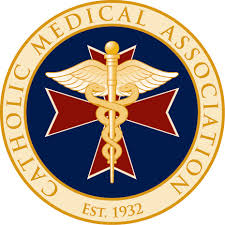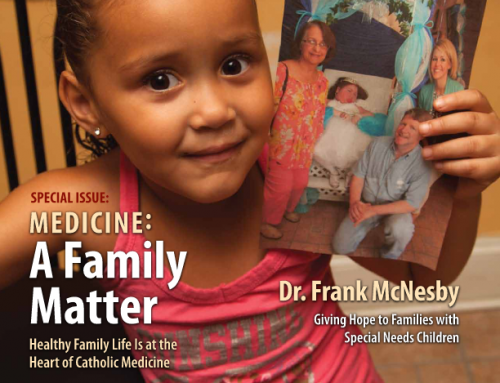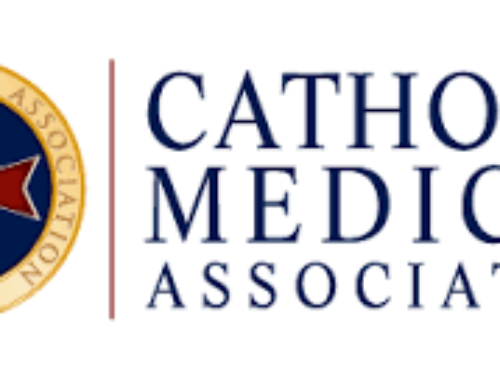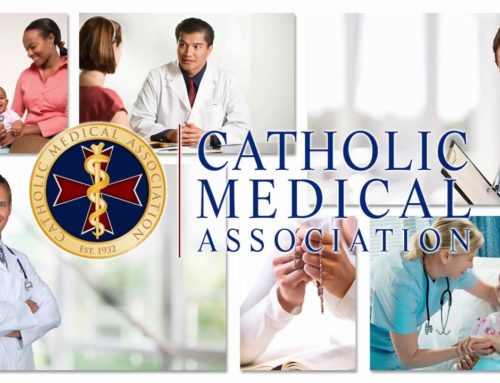The Brief History of the CMA
By Bissonnette-Pitre, Lynne, MD, PhD
The first Catholic Physicians Guild was founded in 1912 in Boston by William Cardinal O’Connell in order to educate physicians in Church doctrine related to the practice of medicine. In 1927 R. A. Rendick, M.D. began a guild in Brooklyn, New York by convening physicians and a chaplain for a retreat using the spiritual exercises of St Ignatius. The purpose of the retreat was to strengthen their Catholic spirituality and to encourage growth in holiness. In the next year the idea of the Catholic Physicians Guild spread throughout the boroughs of New York City and to other cities of eastern United States as many physicians began to gather with a chaplain for spiritual formation.
By 1932 the dream of a national organization of Catholic physicians came to fruition. With the leadership of Dr. Rendrick the National Federation of Catholic Physicians Guilds (NFCPG) began in New York City as a unification of the existing seven guilds. The objectives of the NFCPG were to foster the Catholic physicians’ faith and relationship with God and His Church, the physicians’ knowledge and practice of moral and ethical medical principles and the solidarity among its members. To achieve these objectives the NFCPG formed a Board of Directors who hosted an annual meeting, organized North America into ten regions and appointed regional directors who were given the task of forming local guilds throughout the country.
The purpose of the local guild was to provide spiritual counsel and moral guidance to the local physician members so that the physicians would become more earnestly aware of their dependence upon God, truly Catholic in their practice of medicine and Christ-like in their works of mercy. The locus of each guild was a moderator or chaplain who functioned as the spiritual father and director for his flock of physicians. The guilds met for Mass, spiritual retreats, Recollection, and bioethical seminars. The October 18th Feast of St. Luke, the patron saint of physicians, was the high point of the guilds’ yearly activities. White Masses were celebrated for Saint Luke in hospitals, chapels, parish churches and Cathedrals and everywhere that the physicians routinely gathered with their chaplains.
Simultaneous with the foundation of the NFCPG the Linacre Quarterly was begun. As a journal of the philosophy and ethics of medical practice its purpose was to inform the subscribers of Catholic principles applied to the pertinent medical and scientific issues of the times. The name Linacre Quarterly was chosen to honor Thomas Linacre M.D. who had been a physician and priest in 16th century England and had served as the private physician of Henry VIII. Dr. Linacre founded the Royal College of Physicians and through it regulated the practice of medicine in England. He was well known for his scholarship and high ideals of scientific medicine and Catholicism.
Initially the responsibility for the Linacre Quarterly was shared by the member guilds with each guild taking its turn at submitting all the articles for one issue to a designated local editor. This created a Brooklyn issue, a Boston issue, a Philadelphia issue; etc. After 1944 the circulation of the Linacre Quarterly continued to grow and reached ahigh point of 10,300 in 1965. The first Linacre award was given in 1957 on the occasion of the Silver Anniversary of the NFCPG to Rev. J.J. Flanagan, S.J., editor of the Linacre Quarterly for his outstanding scholarship, journalism and contribution to the journal.
In 1948 there were eleven member guilds in the NFCPG. In 1950 the meeting inAtlantic City was attended by 13 guilds. In 1957 there were 60 guilds; and in 1960 there were 92 member guilds in the USA, Canada and Puerto-Rico with a total membership of 6,110. The 100th guild, Rochester, Minnesota was welcomed in 1961 at a grand celebration in New York City. In 1963 the Federation was the sixth largest medical organization in the country with the membership of 7,000. The high mark was a total physician membership of over 10,000 in 1967.
Guilds varied in size from 6 to 600 members. The largest guild was in Boston; the smallest was in Monroe, Louisiana. Some guilds formed around physicians practicing at a specific hospital; other guilds were composed of physicians in a city, a diocese or a state. In 1961 there was one guild for the physicians of the State of Arkansas, eight for Louisiana and for the most highly organized State of New York, there were twelve guilds. The member guilds of the NFCPG were officially known as Constituent Guilds. Physicians in a Constituent Guild were known as Constituent Members of the NFCPG. If a physician lived in an area not served by a guild, he was eligible to join as an Individual Member. If a physician belonged to a guild that was not a Constituent Guild, he was eligible to join as an Associate Individual Member.
The constituent guild members paid dues directly to the NFCPG and the local guild received back from the Treasurer an amount equal to the local guild dues. In 1950 the NFCPG dues were $1.00 per year. In 1956 the dues were raised to $5.00 and in 1965 the dues were set at $25.00.
The Constitution and By-laws of the NFCPG created a representational organization governed by a Directorship. The Board of Directors was composed of the executive committee (the officers of the Board), Regional Directors, Episcopal Advisor (a Bishop) and the Moderator (chaplain). The United States, Puerto Rico and Canadaformed ten regions with each region represented by two Regional Directors. The tasks of creating guilds, of organizing local and regional meetings and of acting as the liaison between the NFCPG board of directors and the local guilds were given to the Regional Directors.
Each Constituent Guild elected a delegate for a one-year term. The guild delegate represented the guild at the annual national meeting with the right of one vote in all matters before the General Assembly and in the election of officers and Regional Directors.
The Constituent Guilds of each region nominated candidates for the office of Regional Director. The Regional Directors were elected at the annual meeting by the officers and guild delegates and served a term of two years on the Board of Directors. If there were not enough Constituent Guilds in a region to nominate candidates, the Board of Directors made the nominations. The Board of Directors had the power to appoint two Regional Directors to fill vacancies.
Any group of six or more Catholic physicians in the same general area could accept the NFCPG Charter and make a request to become a Constituent Guild of the NFCPG. The Regional Director forwarded to the executive director the guild application with recommendations for each physician stating that he was in good standing in his medical practice and in his parish. The executive secretary then submitted the guild application, the Regional Director’s recommendation and all other pertinent information to the Board for action at the annual meeting.
Upon its inception in 1932, the NFCPG met once each year at the American Medical Association meeting. The reason to meet at the AMA meeting was convenience as the vast majority of physicians in the early decades of the 20th century attended the AMA meeting. The AMA functioned in much the same way that specialty medical associations function today. For one week medical scientific papers were presented for physicians to become current on research and practice. On the Friday of the AMA meeting, the NFCPG conference opened with an officers meeting and Holy Mass celebrated especially for any deceased members of the NFCPG. At the general meeting following Mass each guild delegate gave a report of his guild’s activities of the proceeding year. A dinner for the physicians and spouses was held on Friday evening.
The first year that the NFCPG met at a separate time and place from the AMA was 1956 when the Detroit Guild under president Paul Muske M.D. hosted the 1956 meeting in Detroit. Another first for the 1956 annual meeting was a conference with speakers on current medical moral issues added to the regular program and evening banquet with a guest speaker. The following year 1957 the annual meeting was held inNew York City and the tradition of a conference on medical moral issues with an evening banquet in the city of the NFCPG president was established.
The first four presidents of the NFCPG served a four-year term. In 1948 the term was shortened to two years and in the last decades the term of officers has been one year. From 1932 until 1944 the president of the NFCPG presided over the administrative activities of dues and membership from his own local office. The records and administrative functions shifted location with each new president.
In 1944 the NFCPG set up permanent headquarters in the offices of the Catholic Hospital Association (CHA) in St Louis. This was the beginning of the twenty-one year administrative association with the Catholic Hospital Association. The executive director of the CHA served as the Moderator (chaplain) of the NFCPG, as organizer of the NFCPG annual meetings, as editor of the Linacre Quarterly (the sole Medical-Moral Journal published at that time) and maintained the financial and membership records for the NFCPG. The health care of priests and religious was a particular concern for both the NFCPG and the CHA and together they formed a program to meet these needs.
Both the CHA and the NFCPG came under the supervision of the Social Action Department of the National Council of Catholic Bishops (NCCB). The relationship between the NFCPG and the NCCB was characterized by mutual respect and cooperation for twenty years. The Bishops relied upon the physicians of the NFCPG for their expert opinions on medical issues. In addition the White House regularly asked the NFCPG to brief the administration on the Catholic perspective on current medical-ethical issues.
The twenty-fifth anniversary of the foundation of the NFCPG was celebrated on June 5th, 1957 at the Waldorf-Astoria in New York City. Cardinal Spellman, Archbishop of New York City welcomed the physicians and blessed them on the occasion of their Silver Jubilee. Pope Pius XII sent a letter of congratulations, affirmation, encouragement and an apostolic blessing. [See appendix for the letter of Pope Pius XII]. The Honorary Committee for the Silver Jubilee included His Eminence Cardinal Spellman, His Excellency Richard Cushing, Archbishop of Boston, Averall Harriman, the governor of New York State and Robert Wagner, the mayor of New York City.
In 1961 the NFCPG returned to New York City on the 28th of June to celebrate the affiliation of the 100th guild, the Guild of Rochester Minnesota. Cardinal Spellman again welcomed the physicians with his blessings and prayers [See appendix for Cardinal Spellman’s prayer, the certificate of the 100th Guild and the roll call for 1961].
In 1965 the relationship with the CHA fractured when the CHA endorsed socialized medicine and the NFCPG opposed it. The executive committee of the NFCPG made the decision to dissociate from the CHA. Robert Herzog was hired to serve as the executive secretary of the NFCPG and administrative headquarters were moved toMilwaukee, Wisconsin.
A strain in the relationship with the National Catholic Conference of Bishops began in 1964 over contraception. In 1964 the NFCPG co-sponsored with the Family Life committee of the NCCB a conference in Washington DC on Natural Family Planning. Over 200 Family Life Diocesan Directors attended. During the conference a sub-group of attendees drafted a letter to be sent to Pope Paul VI asking him to endorse the use of the contraceptive pill. After a debate in the general assembly, a substitute resolution was adopted to develop a special commission composed of an equal number of Catholic physicians and family life diocesan directors to study human life, NFP and abortion. The Commission met four times a year in Chicago for years. The physician component strongly supported Humanae Vitae while many of the Family Life Directors openly supported contraception.
In the years subsequent to the promulgation of Humanae Vitae, the NFCPG was torn apart in its interior with successive presidents elected from opposite sides of the contraception controversy. At the NFCPG national meeting in Miami, Florida in 1968 the majority vote of the general assembly supported the Holy Father and Humane Vitae. This so inflamed the president of the NFCPG that he resigned and many guilds separated from the NFCPG. Eventually the strong guilds from Detroit, St. Louis,Milwaukee, New York and Boston as well as a multitude of smaller guilds became virtually inactive. The membership of the NFCPG dropped to a low point of 300 physicians and two Member Guilds: Chicago and Philadelphia. Throughout the next three decades the NFCPG although significantly reduced in size continued its yearly annual meeting and remained vital by the hard work of the physicians loyal to the Catholic Church and to her magisterial teaching.
The international organization of Catholic physicians known as the Federation of International Catholic Medical Associations (FIAMC) also known as the World Catholic Medical Association met in New York City in 1998 in a conjoint program with the CMA. George Isajiw M.D. of the Philadelphia Guild and a Board member of FIAMC served as the program chairman and organized a superb meeting in collaboration with Rick Watson M.D. the president of the CMA. St. Patrick’s Cathedral in New York City and Cardinal O’Connor hosted Mass for the physicians.
In 1997 the Board of Directors changed the name from National Federation of Catholic Physicians Guilds to the Catholic Medical Association (CMA) to reflect that the membership consisted almost entirely of Individual Members. Chicago andPhiladelphia continued as the only Member Guilds and they did not elect delegates to the general assembly. The Regional Directors of the ten regions were appointed by the Executive Committee and served primarily the national organization rather than the region. In fact by 2000 most Regional Directors had no idea what their job description had been at the foundation of the organization. Existing throughout the United Statesand Canada were a few Catholic Physicians Guilds unaffiliated with the CMA and most often unknown to the Regional Directors. Many of these guilds had no members belonging to the CMA while others had a few members in the CMA.
As the new millennium dawned the CMA Board of Directors recognized the problem of being too centrally focused and the failure to serve physicians at the local level. The Regional Directors were once again encouraged to function in accordance with the original Constitution and By-laws with the primary focus on the creation of local Guilds. Consequently many of the independent Guilds have once again become Member Guilds and many new guilds have been formed. The President of FIAMC, Dr. Gigli attended the CMA Executive Directors Retreat in January 2003 to encourage and to affirm the importance of fostering the local physicians guilds.
With the springtime of the new Millennium, the revitalization of the Church and of the Catholic Physicians has begun. Once again Catholic Physicians are seeking to learn of the high ideal of God’s call (vocation) to become physicians to the practice of medicine in conformity to Christ the Divine Physician. The CMA is challenged to be the voice of truth for all physicians and for the community; to keep biotechnology in conformity with the Laws of God; to promulgate the Catholic concepts of person, rights and the common good as applied to the practice of medicine; to defend the sacredness and dignity of life at all stages; and to teach the Catholic norm of morality rooted in its source and authority of the natural law, divine positive law and the ecclesial Magisterium. This is the orthopraxis or ‘right action’ of the Catholic physician.
Tradition teaches that orthopraxis cannot be separated from orthodoxy. While the current concept of orthodoxy is ‘right doctrine’, the Fathers of the Church understood orthodoxy to mean the authentic adoration and glorification of the Lord, the right relationship with God. To be in right relationship with God (orthodoxy) would naturally result in the right action to please God (orthopraxis) [Cardinal Joseph Ratzinger, The Greatest Mystery, Inside the Vatican, Aug-Sept 2002, p.12]. The founding doctors of the CMA (NFCPG) understood this principle and initiated the formation of physicians through spiritual retreats and spiritual counsel.
The CMA strives to serve, to form and to teach its apostolate of Catholic physicians as it did in the beginning through Member Guilds formed in conformity to the CMA. It is the intention of the CMA to have local Catholic Physicians Guilds in every state, diocese and parish in North America in order to carry forth the mission of forming the identity of the Catholic Physician as Icon of Christ the Divine Physician.
——————————————————————————————————————————————————————————————————————————————————–
Past Presidents
|
Brooklyn, New York
New York, New York Brooklyn, New York Brooklyn, New York Brookline, Massachusetts Detroit, Michigan Philadelphia, Pennsylvania Cleveland, Ohio Brookline, Massachusetts Long Island, New York Shreveport, Louisiana Rock Island, Illinois Garden City, New York Houston, Texas Miami, Florida Newport Beach, California West Bloomfield, Michigan Bryn Mawr, Pennsylvania Arlington, Virginia Part Ridge, Illinois Boynton Beach, Florida Milwaukee, Wisconsin Washington, DC Cleveland, Ohio Oak Park, Illinois Milton Village, Massachusetts Buffalo, New York Chicago, Illinois San Angelo, Texas Playa Del Rey, California Philadelphia, Pennsylvania Honolulu, Hawaii Franklin Park, Illinois Rockville Centre, New York Columbus, Ohio Lee’s Summit, Missouri Houston, Texas Reno, Nevada Pontiac, Michigan Upper Darby, Pennsylvania St. Louis, Missouri Augusta, Georgia White Plains, New York Paradise Valley, Arizona Toledo, Ohio Mountainside, New Jersey Lake Placid, New York Pittsburgh, Pennsylvania Ft. Walton Beach, Florida Langhorne, Pennsylvania Ormond Beach, Florida Portland, Oregon Ft. Walton Beach, Florida Tucker, Georgia Towson, Maryland Springfield, Illinois |
——————————————————————————————————————————————————————————————————————————————————–
CHARTERED GUILDS

| State | City | Guild Name |
| AL | Birmingham | Alabama Guild |
| AZ | Phoenix | Catholic Physicians’ Guild of Phoenix |
| AZ | Tucson | Tucson Catholic Physicians Guild |
| BC (Canada) | Vancouver | Vancouver (BC) Catholic Physicians Guild |
| CA | Modesto | Central California Guild |
| CA | Santa Clara | Santa Clara Guild |
| CA | Pasadena | St. Luke’s Society of Orange County |
| CO | Denver | Denver Guild |
| CO | Pueblo | Sangre de Cristo Guild |
| CT | Hartford | Connecticut Guild |
| FL | St. Petersburg | Diocese of St. Petersburg Guild |
| FL | Pensacola | Northwest Florida Guild |
| FL | Orlando | Orlando Guild |
| FL | Palm Beach | Palm Beach Physicians Guild |
| FL | Venice | Southwest Florida Guild |
| FL | Gainesville | St. Gianna Guild of North Central Florida |
| GA | Atlanta | Atlanta Guild |
| IL | Chicago | Catholic Physicians’ Guild of Chicago |
| IL | Peoria | Peoria Guild |
| IL | Rockford | Rockford Guild |
| IL | Springfield | Springfield Guild |
| IN | Fort Wayne | Dr. Jerome Lejeune Guild |
| KS (and MO) | Kansas City | Saint Cosmas & Damian Guild |
| KY | Lexington | Sts. Luke and Gianna Medical Guild |
| LA | Lafayette | Acadiana Guild |
| LA | Alexandria | Catholic Physicians Guild of Central Louisiana |
| LA | New Orleans | Catholic Physicians Guild of New Orleans |
| MA | Worcester | Worcester Guild |
| MD | Baltimore | Baltimore Guild |
| MI | Kalamazoo | Diocese of Kalamazoo Catholic Medical Guild |
| MI | Grand Rapids | Grand Rapids Guild |
| MI | Lansing | Lansing Guild |
| MI | Marquette | Venerable Bishop Frederic Baraga Guild |
| MN | Rochester | Diocese of Winona Guild |
| MN | St. Paul and Minneapolis | St. Paul and Minneapolis Catholic Physicians Guild |
| MN | Duluth | St. Raphael’s Guild of Duluth |
| MO | St. Louis | St. Louis Guild |
| MT | Great Falls | Montana Guild |
| NC | Raleigh | Triangle Guild |
| ND | Bismarck | Bismarck Guild |
| ND | Fargo | Fargo Guild |
| NE | Omaha | Omaha Guild |
| NV | Carson City | Northern Nevada Guild |
| NY | Rochester | Finger Lakes Guild |
| NY | New York | Metropolitan New York Guild |
| NY | Syracuse | Saint Marianne Cope Guild |
| OH | Cleveland | Archbishop Sheen Guild of Northeast Ohio |
| OH | Columbus | John Paul II Guild of Columbus |
| OH | Toledo | Northwest Ohio Guild |
| OH | Dayton | Southwest Ohio Guild |
| OR | Portland | Portland Guild |
| OR | Medford | Southern Oregon Guild |
| PA | Allentown | Allentown Guild |
| PA | Harrisburg | Harrisburg Guild |
| PA | Philadelphia | Philadelphia Guild |
| PA | Pittsburgh | Pittsburgh Guild |
| RI | Providence | Catholic Medical Society of Rhode Island |
| SC | Myrtle Beach | Blessed Clemens von Galen Medical Guild of South Carolina |
| SD | Sioux Falls | Sioux Falls Guild |
| TN | Clarksville | Immaculate Conception Catholic Medical Guild |
| TN | Nashville | Nashville Guild |
| TX | Austin/Round Rock | Catholic Physicians’ Guild of Central Texas |
| TX | San Antonio | Catholic Physicians’ Guild of San Antonio |
| TX | Brownsville | Our Lady of San Juan del Valle Catholic Medical Guild |
| TX | Dallas | St. Rita Dallas Guild |
| VA | Arlington | Northern Virginia Guild |
| VA | Richmond | Richmond Guild |
| WA | Spokane | Spokane Guild |
| WA | Seattle | Washington State Guild |
| WI | Madison | Catholic Medical Guild of the Diocese of Madison |
| WI | Eau Claire | Chippewa Valley Guild |
| WI | La Crosse | La Crosse Guild |
| WI | Marshfield | Marshfield Guild |
| WI | Milwaukee | Milwaukee Guild |
| WI | Green Bay | Saint Gianna Molla Guild of Northeast Wisconsin |







